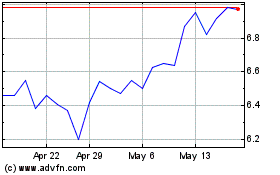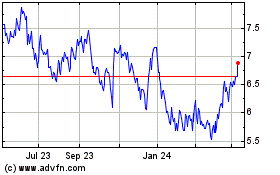By Alistair MacDonald and Rhiannon Hoyle | Photographs by Katie Klann for The Wall Street Journal
A drive by mining companies to hire more women has stalled,
leaving the industry as one of the world's most male-dominated
professions and exacerbating a looming recruitment crisis in many
key roles.
Mining giants including BHP Group Ltd., Rio Tinto PLC and
Freeport-McMoRan Inc. have used apprenticeships, direct recruiting
and more flexible working practices to appeal to women in recent
years, hoping to rebalance their mostly male workforces and help
fill vacancies.
However, a Wall Street Journal analysis of government and
company data shows that, over the past decade, increases in female
workers have plateaued and even fallen back at some companies.
Women are put off by the industry, say female workers and
recruiters, citing a lack of flexibility in a career that can
include months away from home at isolated sites. Other deterrents
include a perception that they don't have the same opportunities as
men, what some describe as a macho culture, and incidents of
harassment, they say.
"You can't just say, yes, diversity is good and we will just let
it happen organically, because it won't," said Amanda Lacaze, chief
executive of Australia-listed Lynas Rare Earths Ltd. and one of the
few female heads of a mining company. "We have seen that over many,
many years."
The struggle to recruit women has added significance for an
industry where executives say it will be difficult to replace
retiring engineers, geologists and drillers because those roles are
no longer seen as attractive by younger workers who prize more
flexibility and work-life balance.
"In the next five years, I think we are going to really struggle
because we just aren't generating enough" graduates, said Jason
Economidis, chief operating officer of Australian miner South32
Ltd.
In the U.S., 14.3% of people employed in mining in 2020 were
women, only 0.3 percentage point higher than in 2015. About 47% of
the overall U.S. workforce is female.
Figures are similar in Australia, Canada and Europe, with little
progress boosting female participation in recent years. Only
construction has a lower percentage of female workers than mining,
according to a 2019 survey by the World Economic Forum that looked
at 16 major industries.
The proportion of female workers varies across miners. At
Barrick Gold Corp., 10% of the workforce is female, down from 11%
in 2015 and 12.5% in 2009. The company did not immediately respond
to a request for comment.
BHP says more than 27% of its workers are women, up roughly 10
percentage points since 2015.
While it has made greater inroads than its peers, BHP, like
other miners, has work to do to reach self-imposed gender targets.
BHP would need to nearly double the proportion of women within four
years to hit its goal of having a gender-balanced workforce by
2025.
Elsewhere, Freeport had aimed for 15% of its workforce to be
women by now, but the proportion has hovered at 13% for the past
three years, while Fortescue Metals Group Ltd. missed a target to
have a 25% female workforce by last year: As of April, around 21%
were women.
The industry must work harder to overcome deep-seated structural
barriers for women, said Tara Diamond, operations director at
Australian Mines and Metals Association, or AMMA, an industry
group.
As well as attracting more women to science and engineering
studies, these include "changing the image and cultures of the
industry from being 'blokey' and male-dominated, and clamping down
on workplace sexual harassment which in our industry is higher in
prevalence than the average across all sectors," Ms. Diamond
said.
BHP is trying new entry-level training programs and boot camps
to attract women in countries ranging from Australia to Chile, as
well as rolling out flexible work.
At some remote mine sites in Western Australia, BHP is giving
workers the choice of up to 12 different roster options, rather
than being locked into the standard routine of two weeks on, one
week off. And some workers who would have previously needed to be
at a mine, such as maintenance support staff, now have options to
work from home.
"We know that we need to do something fundamentally different,"
said BHP's Chief People Officer Athalie Williams, noting that women
have historically sought more flexible work, particularly if they
have children.
Retaining female workers has also been a problem for mining
companies. Data from Freeport shows 22% of female employees left
the company last year, against 14% of male workers. The company is
looking for ways to support inclusivity and women in the workplace,
a spokeswoman said.
Lacey Filipich joined the profession in Australia straight out
of university in 2004, but she quit her job as a training manager
six years later after the birth of her first child.
"I wanted more flexibility, to see the baby grow up," she said.
At the time, the shortest period working away from home on offer
was four days on site. Ms. Filipich returned for a stint in 2018
but now runs a business providing financial education.
The 38-year-old believes female managers are essential to making
the profession accessible for women. She said she had worked at
male-run mine sites where there weren't any separate female toilets
and women expressing milk after childbirth did so in supply
closets. By contrast, at a female-run site, there was a room and
refrigerator reserved for breast-feeding women.
To support moms returning to work, Fortescue said it has set up
a child care service at its Perth office and an in-home care
program for children of workers in the northern Australia town of
Port Hedland.
Mining's struggle to recruit more women is reflected in other
male-dominated professions. In the U.S., the proportion of women
working in construction, at 13.3%, has barely moved since 2010. In
manufacturing, it has fallen since 2000, to 28.4% from 31%,
according to government data.
But few industries have such acute shortages in skills as
mining. In Canadian mining and quarrying, the ratio of the employed
to vacancies, a measure of demand for new jobs, is 1.4 to one,
government data shows. In construction there is one vacancy for
every 4.8 workers.
Some women believe the mining industry doesn't offer them the
same opportunities to advance as men. Half the 1,000 women in
mining interviewed in a recent survey by McKinsey & Co. thought
this was the case.
Marian Boatemaa had wanted to be a miner since a high-school
trip to a mine in Ghana, where she noticed there were no women.
During her studies and when she was working, the 30-year-old said,
men told her women weren't cut out for mining.
"They would pass comments saying mining is not for women, women
are not tough enough," said Ms. Boatemaa, who works as a
geotechnical engineer at a Colorado mine owned by Newmont Corp.,
which she says has offered an inclusive environment.
The location of mines can also be problematic. In some
developing countries where mining companies often operate, women
can be discouraged from working, while female workers say it can be
difficult being the only women in remote places.
"Is it uncomfortable to walk through a kitchen of 800 men? Yes,"
said Karen Hincks, an engineering geologist who has worked at mines
across Canada.
An estimated 74% of women in the Australian mining industry were
sexually harassed at work in the five years to 2018, a report by
the Australian Human Rights Commission said. That was second only
to the information, media and telecommunications industry, in which
an estimated 80% were, the report said.
Miners say they are introducing sexual-harassment and
sexual-assault awareness training for employees, improving security
at mines and enhancing investigation processes.
Ms. Hincks says the majority of her male colleagues behave well,
but one man once tried to lift her shirt up and others have made
lewd comments.
"You would say something and then they would say, 'I know what
you can do with that mouth,'" she said.
Write to Alistair MacDonald at alistair.macdonald@wsj.com and
Rhiannon Hoyle at rhiannon.hoyle@wsj.com
(END) Dow Jones Newswires
June 10, 2021 05:50 ET (09:50 GMT)
Copyright (c) 2021 Dow Jones & Company, Inc.
Lynas Rare Earths (ASX:LYC)
Historical Stock Chart
From Feb 2025 to Mar 2025

Lynas Rare Earths (ASX:LYC)
Historical Stock Chart
From Mar 2024 to Mar 2025
